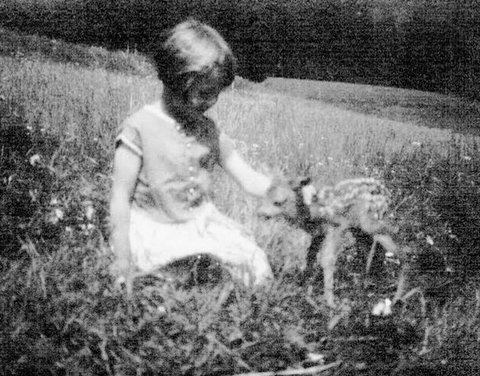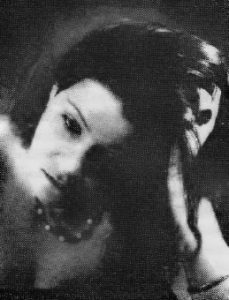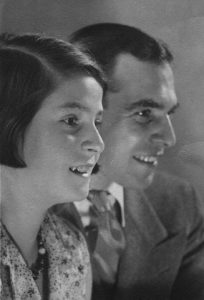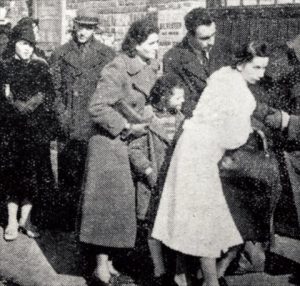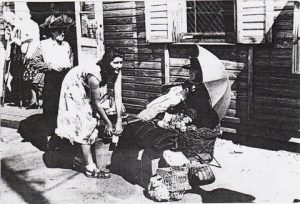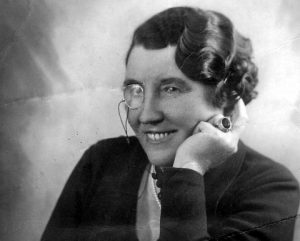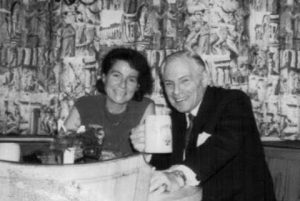By Peter Vanlaw
Some of you may know my cousin Eva Baruch’s story, from my film “For the Life of Me” and the many blog posts I’ve written about her, along with many of the people who were part of her life. But for those of you who don’t know her story, here’s a brief synopsis:
Cousin Eva’s life reads like a movie script, because of her numerous cliffhanger escapes, and the circumstances surrounding them.
During the mid-1930s in pre-WWII Berlin, Eva had become a successful actress in German theater, following in the footsteps of her actress mother. But it wasn’t until 1938, when the Nazis threatened her very existence, that she fled with her parents to Shanghai.
Here she began working again in both legitimate theater, and in radio, producing some anti-Nazi radio plays for the British. Then suddenly, wanted by the Shanghai Gestapo, she was forced to flee again just a few days before December 7, 1941. That’s when the Japanese attacked Pearl Harbor and simultaneously sealed off Shanghai from the outside world.
Landing in Australia, she was forced to wait out the war there before being able to return to her Homeland. But because of her very strong anti-Nazi feelings, she chose East Berlin as the place to resume her post-war theatrical career—only to find herself in trouble once again. It was during the violent East German Workers’ Strike, when she had sided with the workers and was severely punished by her Communist bosses.
Now, no longer able to work in Berlin, she found her life in East Germany untenable and fled once again—only this time it was across the border to West Germany just as the East Germans erected the Berlin Wall.
Now, if you can imagine this irony of ironies: at one time I’d given up trying to include her story in my embryonic film. I didn’t think I could find enough background information and film footage to make her story into something that was both interesting and filmic! Little did I know then how her story would take on a life of its own!
Fortunately, for the sake of the project which we later titled, “For the Life of Me”, my creative partner, Bob Sallin, pleaded with me to continue my research. After reading my very sketchy story notes about Eva, he insisted that her story HAD to be in the film.
Those notes were based partially on what little my mother told me about Eva, combined with a short but intriguing bio about her that someone sent from the University of Hamburg Library in Germany.
But it was that short bio that excited both of us, hinting that there was much more to be revealed. If only we could find it. Bob became so intrigued by what may be out there that he convinced me to spend the next few months tracing her life, hoping that we could find enough material to fill out her story and include it in the film.
Little did we know then just how much material I would unearth—so much, in fact, that we couldn’t fit it all into the film. It didn’t take long to realize that telling her entire story would require a complete film exclusively about her.
I had already made some wonderful contacts, both here and abroad, researching my Uncle Paul’s story primarily through the resources of JewishGen. So it was a natural fit for me to return to those earlier contacts to learn more about cousin Eva.
Doing that kind of research on the internet always made me feel as if I were throwing a metaphorical “message in a bottle” into the worldwide waters of the internet. Then sitting back waiting for the answers. And sure enough, in Eva’s case, they came back quickly, washing up on the shores of my browser. Information began rolling in from JewishGen members in the U.S., Australia and Germany, all eager to help.
It was during that time that I received a cryptic email query from someone in Australia looking to make contact with the person who’d put up a family tree on JewishGen’s Family Tree of the Jewish People that included Eva Baruch and her family. Since that person happened to be me, I wrote back, only to learn that the curious sender was none other than Eva’s only son, Michael. And thus he became one of my early, go-to sources of information. Some of it went into the script, but some didn’t because it couldn’t be confirmed. Then very recently some of it was. But we’ll get into that later.
Yet even after “For the Life of Me” was sufficiently finished to begin having screenings for private groups, more information continued to filter in. For example, an update from my dear friend in Celle, Germany, Ralph Hirsch. He found some new information and was eager to put me in touch with a film producer friend of his by the name of Paul Rosdy.
Rosdy was living in Vienna at the time, and had written, produced and directed a wonderful documentary about the European Jews who fled to Shanghai before WWII, and how they were able to recreate their European lifestyle during the war years. The film also happened to show a publicity photo of Eva.
Called, “Zufluct (Refuge) in Shanghai – Port of Last Resort”, his documentary was a retrospective done in the late 1990’s, long after the war was over. But during production in China he learned about Eva, and learned that in addition to her theatrical and radio work, she had starred in a film that was shot in 1941, the refugee era.
In 1940, hoping to raise money for the thousands of Jews already displaced by the Nazis, the European War Relief financed a film about the plight of those who had fled from Europe to Shanghai. It had been produced and directed by a very accomplished German-Jewish filmmaker by the name of Greta Wolfson, who was a refugee herself.
But on December 8, 1941, just as all of the principal photography was completed, the Japanese shut down the city and confiscated the film.
Learning about it years later, while researching his own film, Rosdy became obsessed with finding that footage. He sincerely hoped to finish the film and finally release it to the world as “found footage”. It would be a “feature documentary” from that era. As a result, he spent years trying to locate it. But sadly he never found a single frame.
When, through Ralph Hirsch’s connection with Rosdy, I was able to contact him, Rosdy was eager to give me large amounts of information from his own research, including magazine articles about his quest. But more important was a front-page story from a Shanghai newspaper about the filming, with numerous production photos, including Eva and her co-star. All of these taken while the movie was being shot.
But this revelation was way too much and too late to fit in my film, so it became part of the backlog of information that has since gone into my blogs. At that point, I thought Eva’s story was surely dormant. A number of years went by with no new information.
Then suddenly last year, I was contacted on Facebook by a woman in Germany, who had been given a copy of my story, “Who Were the Shanghai Twelve?”.
When I responded, she sent me an email introducing herself as Sonja Muhlberger née Krips. It turns out that she was born and raised in Shanghai during WWII. And with her first-hand knowledge, she had become the “go-to” source, and co-author of a number of books on the subject.
This was amazing to me because she knew every one of the players that had helped me with my original research, and more. But then she was also the bearer of the sad news that my friend and Shanghai scholar, Ralph Hirsch, had passed away.
On the brighter side, she also happened know a dear friend of mine who is still living. And like Ralph Hirsch, was a child from Berlin, who grew up in Shanghai’s Jewish ghetto during the war.
Then, if that wasn’t enough, she sent me copies of a German newspaper from 1947 that pictured Eva’s and her mother Kaete’s arrival back in Berlin, after they left Australia. Sonja kept a copy of the newspaper “Der Weg”, dated August 29, for all these years because, by coincidence, she had arrived from Shanghai with her parents on the same ship.
She also had copies of some of Eva’s more personal letters, written after the war ended. These were written when she was still living in Australia, but was estranged from her husband while caring for her young son. Some of it was personal stuff that her son, Michael, had hinted at years earlier, but couldn’t be confirmed at the time.
Among other revelations I was surprised to learn that while Eva was waiting to find out if and when her mother, Kaete, intended to leave Shanghai, and join her in Melbourne, she voiced some serious mistrust of her older brother, Barry Baruch. It appeared that while living in China during the war, an extreme ideological schism had grown between the two. Accusing him of being a “reactionary”, she even suggested that he might have been a Japanese collaborator!
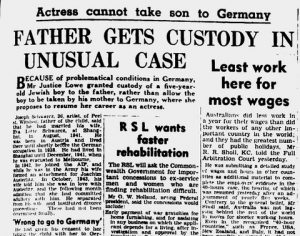 Then, just a few months ago, while re-editing my film, my editor suggested that it would be dramatic if we could find any Australian newspaper articles about Eva’s divorce. Seeing it visually would help support and clarify what up to now was only a rumor. That the trial had become so sensational that it reached the newspapers was in part because the courts refused to allow her to take her son back to Germany with her, and in part because the trial became sensational over some of the juicier revelations.
Then, just a few months ago, while re-editing my film, my editor suggested that it would be dramatic if we could find any Australian newspaper articles about Eva’s divorce. Seeing it visually would help support and clarify what up to now was only a rumor. That the trial had become so sensational that it reached the newspapers was in part because the courts refused to allow her to take her son back to Germany with her, and in part because the trial became sensational over some of the juicier revelations.
It was a long shot since we didn’t really know if it actually did reach the newspapers. But it was certainly worth a try.
One of the first people I reached out to was Naomi Ogin, who lives in Australia. She had been an enormous help to me during my original research almost a decade ago, responding to my inquiries on the JewishGen Discussion Group. This time she didn’t hesitate a beat. And her reply was almost instantaneous. She found not one but three newspaper articles, and even more personal information about Eva.
Suddenly I was overwhelmed by almost more information than I really wanted to know. Yet some of the details confirmed what I originally thought had been erroneous information from her son, Michael, a decade earlier.
Then, a couple of months ago, out of the blue, I received an email from a person who introduced himself as Wolfgang Neusch. He claimed to be related to Eva’s mother, the actress, Kaete Horsten, whom it turns out was never a Horsten, but a Schumacher—Horsten being merely her stage name.
Wolfgang’s father was Kaete’s half-brother. So, Kaete was his aunt and he is my half cousin…. I guess. Nevertheless, he brings a whole new Gentile branch to the Baruch side of our family, with a long line of actors and performers reaching back to the mid-19th Century.
Ironically, while he’s connected more closely to Eva genealogically, since her mother was his aunt, he barely knew her. He was far closer to Barry, spending a large part of his adult life working in the Far East in some of the same places where Barry worked. As a result, Barry became kind of a mentor to him.
Yet paradoxically Barry represented the Jewish side of the family, while his sister, Eva, through her mother, Kaete, represented the Gentile side. This is all because Barry’s mother was Lina Lowenstein, his father Siegfried’s first wife. While Eva’s mother, Kaete, was Siegfried’s second.
When my mother lived with her Aunt Kaete and Uncle Siegfried in the Baruch’s home, she knew her cousin as “Bari”, spelled the only way I knew until Wolfgang’s recent appearance. That’s when I learned that after he fled to Shanghai, Barry never returned to Germany until many years later, and then
only for visits.
Sometime, during his many years living in the Far East, Barry Baruch changed his name to “Bill Barry”. In this international setting he no longer wanted to live with a surname that was both
biblical and Hebrew.
I’ve since received dozens of emails from Wolfgang, asking and answering countless questions that we both have. But it isn’t just the information that we’ve been able to exchange, but our family photos as well. I’ve sent him pictures of his aunt Kaete and his cousin Barry that he’s never seen. And in exchange he’s come back to me with dozens of other family photos that I’ve never seen either. The picture of Eva with the fawn is an example.
Then just recently I received some photos from him that put my concerns to rest that there was a life-long breach of trust between Eva and her brother. From these photos, taken in Cologne in 1965, it seems obvious that their mistrust had long since been put to rest.
From all of this, I have a very strong feeling that Eva’s story will just keep on ticking.
September 2017
Los Angeles, California, USA
A slightly different version of the above story was posted in Peter’s blog. For more stories by Peter Vanlaw about Eva Baruch and the Shanghai Twelve, see:
Eva Baruch-Actress, Activist or Spy:
Chap. 1 – https://forthelifeofme-film.com/2014/01/25/eva-baruch-actress-activist-spy-chap-1/
Chap. 2 – https://forthelifeofme-film.com/2014/02/10/looking-eva-baruch-part-2/
Chap. 3 – https://forthelifeofme-film.com/2014/03/01/eva-baruch-actress-activist-spy-part-3/
Chap. 4 – https://forthelifeofme-film.com/2014/03/25/evas-story-chapter-4/
Who Were The Shanghai Twelve? – https://forthelifeofme-film.com/2016/06/01/shanghai-12/
Research Notes and Hints
JewishGen played a key role in Peter’s research:
- Peter received valuable information in response to his JewishGen Discussion Group inquiries: https://www.jewishgen.org/JewishGen/DiscussionGroup.htm
- Peter’s posting on the Family Tree of the Jewish People led to his contact with Eva’s son. https://www.jewishgen.org/gedcom/ . If you haven’t yet posted your tree, we encourage you to do so.
A key contact and resource was also made through Facebook from a woman in Germany who had first-hand information about Shanghai during World War II and had written books on the subject.
Peter’s website and blog regarding his film For The Life of Me attracts many readers and potential resources. https://forthelifeofme-film.com/
